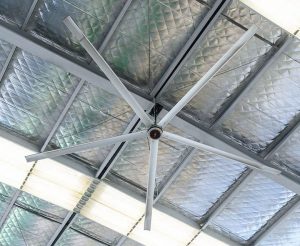Drafty offices, loud whirring noises, and hot spots in large rooms can ruin productivity. These everyday annoyances become worse when a smaller fan spins loudly but barely cools the air. The solution? Invest in a bigger fan or an advanced ceiling fan design that provides calmer airflow and a better experience.
A bigger fan is typically quieter because it delivers the same amount of air at lower speeds, reducing turbulence and mechanical noise. A large fan with wider blade size moves more air per minute without needing to spin faster, so it creates less fan noise. Smaller fans running at high rpm tend to make more noise because they cut through the air more aggressively, generating extra turbulence and higher db levels.

HVLS Fan Demo
Airflow in fans can be a game-changer for occupant comfort, air temperature control, and noise management. But why is a big ceiling fan or pc fan sometimes much quieter than a tiny model?
A larger fan can move a lot of air by rotating at lower speeds. In contrast, a small fan might need a high rpm to achieve the same volume of air. High rpm typically results in more turbulence and fan noise, causing a higher db reading. For instance, an 80mm fan in a computer often works harder than a 120mm counterpart to achieve the same cfm (cubic feet per minute of airflow).
When a fan’s blade crosses through the air more slowly, it creates fewer chaotic currents. Rapid motion can generate a lot of friction and swirling eddies, which create more noise. By spinning at gentler speeds, bigger fans provide stable air flow with less disruption, leading to less vibration and a lower noise level overall.
Pro Tip: A bigger fan can handle the same amount of air movement at half the rpm of a smaller unit, which also cuts mechanical noise.
Turbulence is a major contributor to a fan’s noise level. When air molecules swirl irregularly around the fan blades, they can make more noise as they collide with surfaces and each other.
Case Study: In an effort to reduce fan is loud complaints, a factory installed a state-of-the-art HVLS system. They found that the bigger blades drastically curtailed the swirling noise produced by smaller units that had to run at higher speed to keep the area cool.
When considering a ceiling fan for a gym, warehouse, or home, you may wonder whether a small fan can suffice. Or do you need a broad-spanned overhead system? The difference often comes down to how much air movement you need and how large the space is.
A small fan must spin faster to produce enough breeze, so it’s more likely to be louder. If you want a quieter than others solution for big open rooms, consider a wide-blade ceiling fan design.
Industry Insight: Some industrial settings use overhead HVLS units that are significantly quieter than a cluster of smaller floor fans. The occupant experience is also improved, as you reduce tripping hazards or clutter from multiple fans on the floor.
Acoustics plays a huge role in fan noise. The more air a fan displaces per rotation, the less it needs to spin. This approach means fewer pressure waves hitting your eardrums, which lowers perceived loudness.
HVLS fans in particular are much quieter than small desk fans or high-rpm CPU coolers because they revolve at gentle speeds. This gentleness reduces turbulence and leads to calmer, more uniform airflow patterns.
In the pc fan world, you might see 80mm fan models or a 120mm or even 92mm variant. Each has a distinct purpose for cpu or gpu cooling. But if you want less noise, bigger is often better.
Community Insight: On ars openforum, enthusiasts discuss how an 80mm or 60mm delta fan is often extremely loud, whereas switching to 120mm or 92mm can be quieter than others. Some use a 7v adapter to reduce rpm further and achieve near-silent performance.
HVLS fans (High Volume Low Speed) revolve around the concept of shifting a high volume of air at low rpm. They use wide blade spans—some up to 50cm or more—to push air gently but effectively.
Fans often are used to replace many small units. By providing calm, quiet airflow, these advanced fans help keep cpu-like environments or big indoor spaces from overheat or feeling stuffy.

How HVLS Fans Work
The blade design drastically influences both airflow efficiency and noise. A well-engineered blade size can keep the noise level minimal while delivering adequate air flow.
A fan’s alignment and balanced blade shapes matter. Loose or misaligned fan arms cause uneven distribution and can cause the fan to vibrate or squeak. Manufacturers with strict tolerance standards usually produce fans that are much quieter.
HVLS Example: Large industrial overhead fans with carefully contoured edges keep warm air from stagnating near the ceiling, while drastically reducing swirling or buffeting.
HVLS Fan in warehouse
Whether it’s a cpu cooler or a big ceiling fan in a factory, the size of the fan is crucial in achieving a balance of performance and silent operation. A pc fan with an 80mm or 120mm diameter tries to keep your proc stable and safe from meltdown. Meanwhile, an overhead ceiling fan might measure 50cm to 2 meters or more, ensuring the entire room stays cool.
In a manufacturing plant or sports center, a small overhead fan simply can’t push much air around. Instead, a big HVLS overhead system sends fresh breezes to the floor, even if the building stands 30 feet tall. The gentle swirl keeps employees or patrons comfortable and fosters a more cooler environment overall.
While bigger typically means fan is much quieter for the same airflow, there are times a smaller fan or two fans might be beneficial. Let’s weigh the pros and cons.
Two fans approach can sometimes help: you place a moderate-sized overhead fan plus a specialized smaller unit for specific hot spots. In other scenarios, a single HVLS can handle the entire area more elegantly.
How do I reduce fan noise without replacing the entire unit?
You can lower rpms with a 7v adapter or a built-in controller if your fan’s motor supports it. But keep an eye on temps: too slow could cause your CPU or space to overheat. Also, check if any sheet metal parts are rattling, as that can amplify noise.
Which is better for a desk build: 80mm fan or 120mm?
Generally, a 120mm is quieter than others if you want the same airflow. The 80mm fan must spin faster, so it tends to generate more whine. If your power supply or case accommodates bigger fans, that’s usually the best route.
Does a bigger ceiling fan always produce less mechanical noise?
Usually. Because a bigger fan can move the same volume of air at lower rpms, it’s much quieter than a smaller overhead fan that must spin faster. But pay attention to brand quality, blade shape, and turbulence factors.
Why do fans come in various sizes like 60mm delta or 92mm papst?
Each size addresses a distinct cooling or ventilation scenario. For instance, a 60mm delta is extremely powerful but can be louder, while a 92mm papst might strike a good balance between cool performance and noise levels.
Is a bigger fan recommended for AMD builds?
Yes, especially if your AMD processor or GPU runs hot. A larger fan design can push or pull more air flow at moderate speeds, giving you a much quieter user environment.
Why do some fans may create squeaks at higher speeds?
At high rpms, small vibrations get amplified. Any slight imbalance or friction can become audible. This phenomenon is typical in fans that must spin vigorously to produce enough airflow.
In summary: A bigger fan is often much quieter because it can handle the same air capacity at lower rpms. This concept applies to everything from an 80mm or 120mm pc fan to a massive overhead ceiling fan. By spinning more gently, bigger devices can reduce mechanical noise significantly, letting you enjoy consistent cool climates with minimal disruptions. Embrace a large fan approach and see how it transforms your environment with fans help keep your space calm, comfortable, and effectively cool—without the roaring turbulence smaller units may cause.

Hi, I’m Michael Danielsson, CEO of Vindus Fans, with over 15 years of experience in the engineering and design industry. I’m here to share what I’ve learned. If you have any questions, feel free to contact me at any time. Let’s grow together!